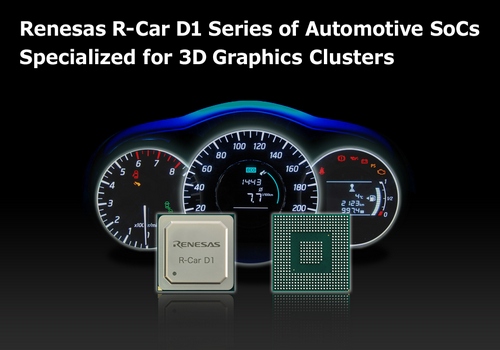New SoCs Implement 3D Graphics as High-End Version of the Successful 2D Cluster MCU Series
Renesas Electronics announced the availability of the R-Car D1 Series, as the first member of system-on-chips (SoCs) in the R-Car Family specialized for 3D instrument cluster systems. Leveraging its deep knowledge and expertise as the market leader in the automotive semiconductor market (Note 1), Renesas is introducing the new series to provide a smooth migration path for automotive system manufacturers as more automotive systems are expected to shift to 3D graphics instrument cluster systems in the near future.

As the use of color LCD panels in instrument cluster systems becomes more widespread, gauge control and graphics display are being combined even in smaller and medium size cars. The trend towards "gauge-less" displays is already progressing in high-end cars, where visibility and comfort are desired, and attractive, easy to see displays using 3D graphics on large, high-resolution panels are seen as one aspect of a car's individuality. In the future, display size and resolution are expected to continue increasing, even in the graphics displays used in low- to mid-end cars, along with the use of cluster systems that provide 3D graphics similar to that used in high-end cars.
However, for these systems to become more mainstream the ability to realize rich reality image display that makes full use of 3D graphics, the ability to display the cluster screen rapidly at the same time as the start-up of accessories, the ability to realize high reliability that can prevent unauthorized access from the outside to the system to continuously convey accurate information of the instruments to the driver, and the ability to enhance the performance of the many electronic equipment units and communications systems used in the car will all be required.
The R-Car D1 provides both the functionality and the performance to overcome these issues and furthermore, since Renesas users can take advantage of the R-Car Consortium ecosystem that consists of over 170 companies, they will be able to develop 3D graphics cluster systems quickly. Renesas will promote the more widespread use of 3D graphics.
The Renesas R-Car Family of SoCs implements high-functionality human machine interfaces (HMI) for high-end automotive cockpit systems. Renesas also offers gauge control support through its RH850/D1x microcontrollers (MCUs) that are also ideal for entry-level and mid-range automotive systems.
Key features of the R-Car D1 Series:
(1) 3D graphics cluster systems can be developed easily by cooperating with Renesas partners
Although good view-ability and high-quality design are important to improve visibility and comfort in cluster systems with full graphics, at the same time, for users with limited experience in 3D graphics development, the time required for development is an impediment. Based on Renesas’ extensive experience developing HMI solutions, along with partner companies who have expertise in developing graphics systems, Renesas provides solutions that can easily express the images created by a graphics designer as a cluster system. This makes it easy for system manufacturers to develop their own 3D cluster systems.
(2) Enables rapid startup for instrument cluster systems
Instrument cluster systems require a rapid startup so that, for instance, immediately after the driver opens the driver's side door, or at the same time accessories are starting up, the system can instantly display the screen or output audio run at high speed. Renesas, along with their partner companies participating in the R-Car ecosystem, provides solutions that support high-speed system startup, rapid display of meter and gauge screens, and audio output.
(3) Driver safety protection and car hacking prevention by the provision of functional safety and security solutions
Since instrument cluster systems may cause serious accidents should they malfunction, it is desired that, to provide the driver with correct information, these systems continuously monitor whether or not correct information is being output and, should a malfunction occur in the system, the malfunction needs to be immediately detected. To implement high-reliability systems, R-Car D1 supports the ISO 26262 standard for automotive functional safety. Renesas provides a Functional Safety Support Program to implement functionally safe systems.
Furthermore, since it is necessary to prevent hacking from outside the system to implement safe and secure systems, the RH850 32-bit MCU that includes hardware security functions can be combined with the R-Car D1. This makes it possible to construct systems that assure data robustness and prevent hacking.
(4) Superlative system flexibility and ease of design made possible by the R-Car D1 supporting a wide range of communication and network types
The R-Car D1 includes the wide variety of communications interfaces required in an instrument cluster system. Since the R-Car D1 supports this range, including Ethernet AVB for connection with navigation systems, USB to connect with smart phones, and CAN-FD to connect with automotive infotainment systems, it supports superlative system flexibility and ease of design.
(5) Development assets from the 2D graphics cluster RH850/D1x can be applied
The RH850/D1M Group of MCUs can implement both gauge control and 2D graphics display with a single chip and is already used in a wide range of cars. Since the R-Car D1 SoC includes the same 2D graphics system as that used in the RH850/D1M, system manufacturers can make use of these 2D graphics development assets, and develop 3D graphics systems for the R-Car D1. Also, if gauge control is required, system manufacturers can also combine the R-Car D1 with the RH850/D1M to implement such systems.
Availability
Samples of the R-Car D1 Series are available now. Mass production is scheduled to begin in March 2017 and is expected to reach a volume of 100,000 units per month by March 2018. (Availability is subject to change without notice.)
